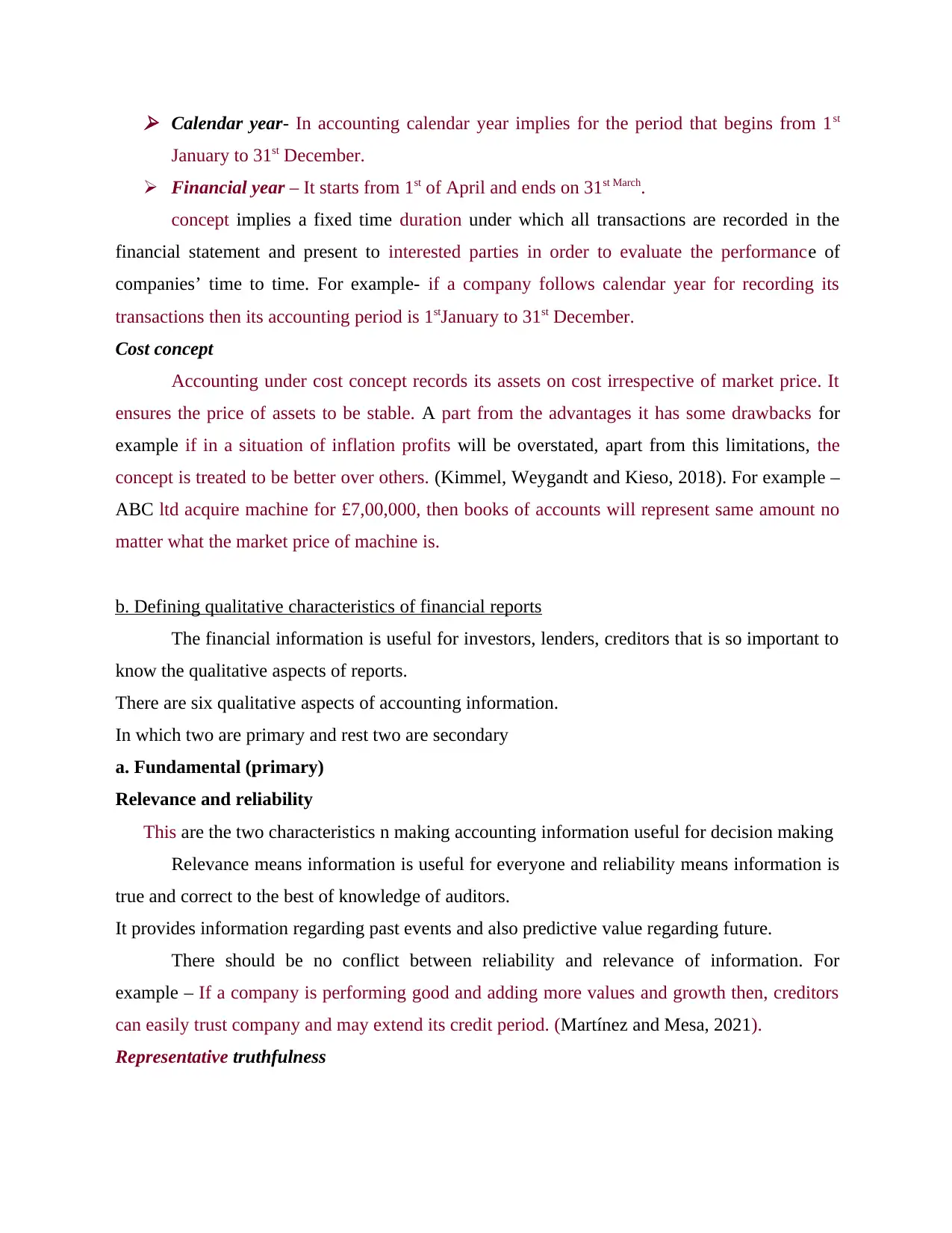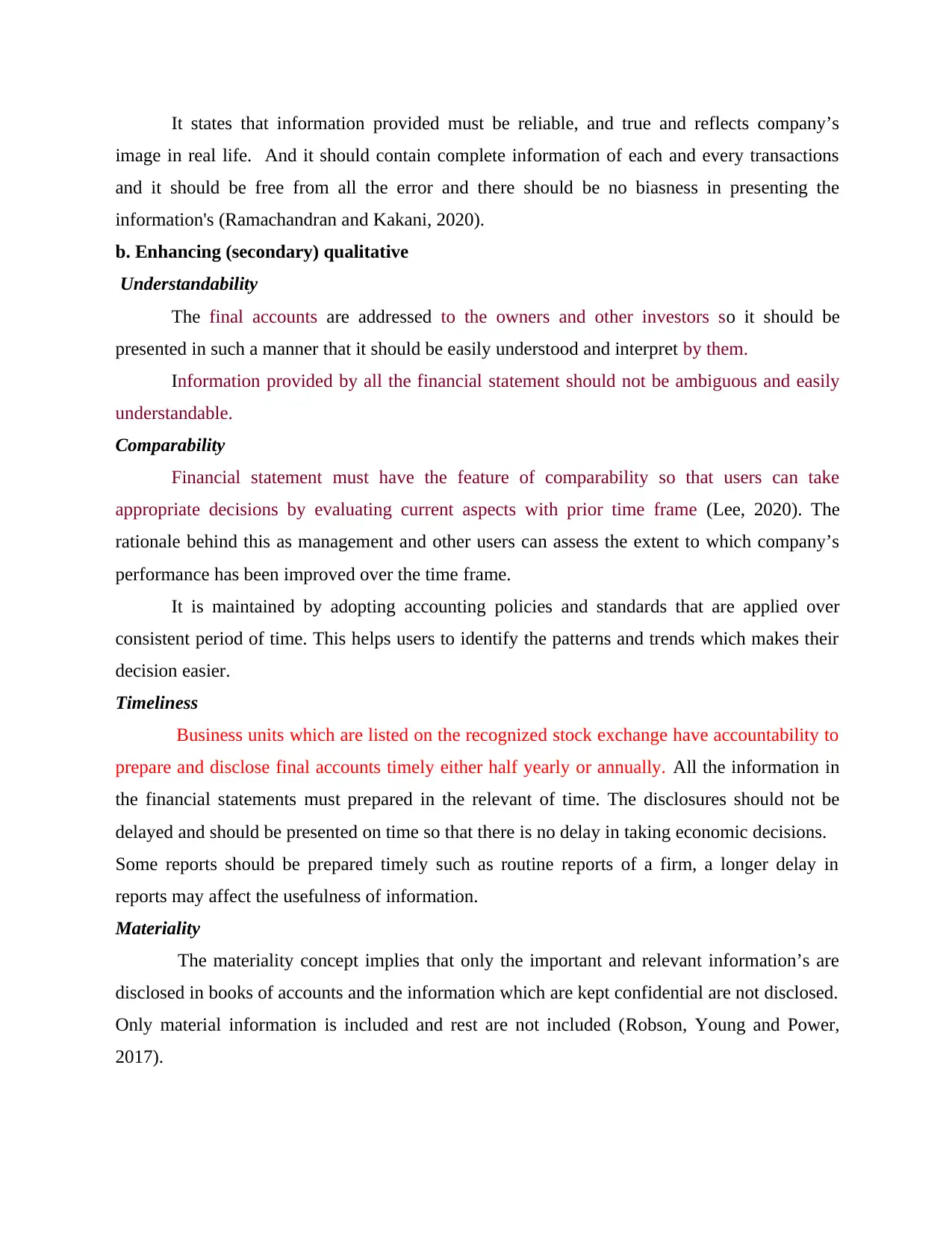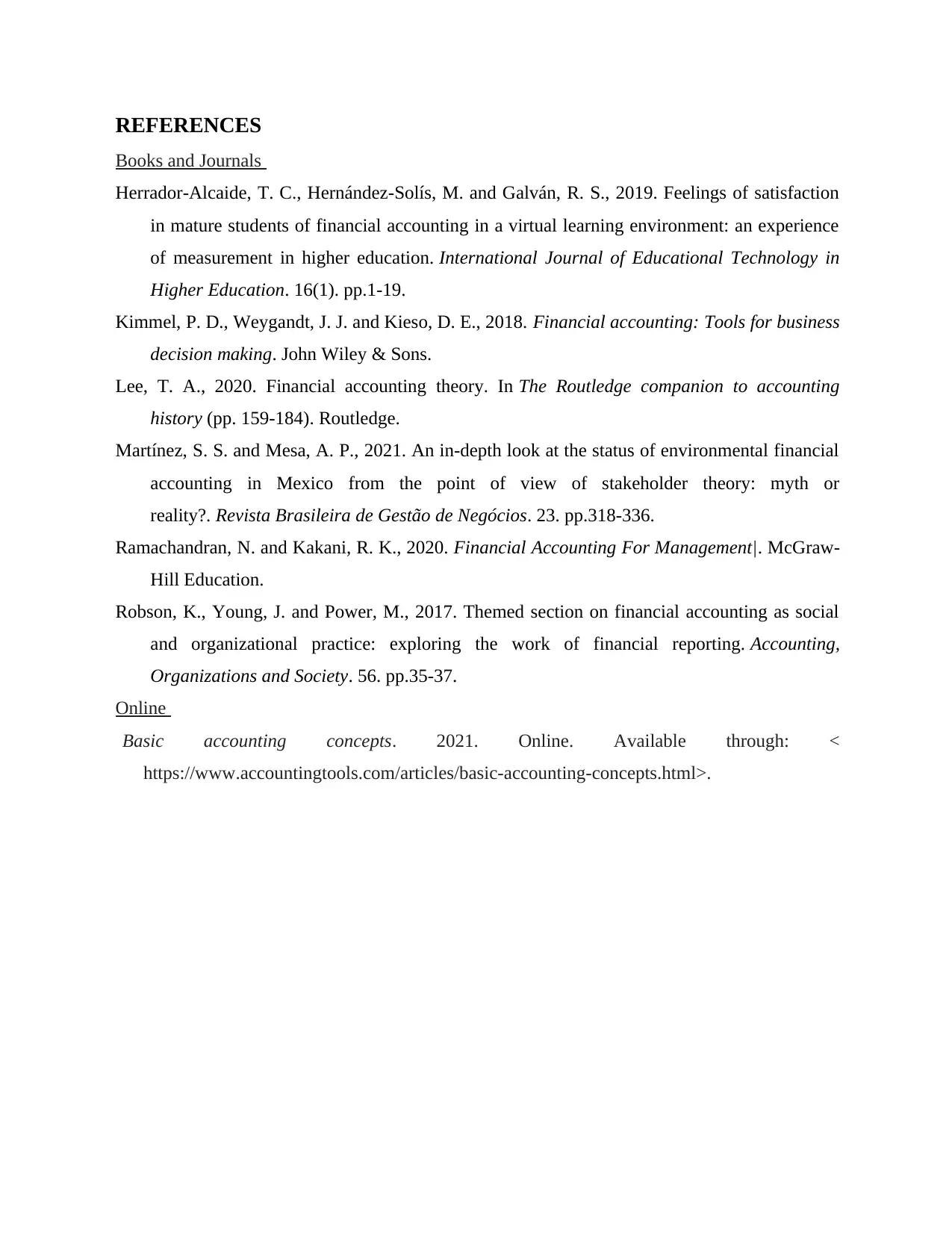Accounting for Business: Concepts, Characteristics & Applicability
VerifiedAdded on 2023/06/18
|7
|1397
|452
Essay
AI Summary
This essay discusses five fundamental accounting concepts (business entity, money measurement, going concern, accounting period, and cost concept) and their applicability in preparing final accounts. It also defines and explains the qualitative characteristics of financial reports, including relevance, reliability, representational faithfulness, understandability, comparability, timeliness, and materiality. The essay emphasizes the importance of these concepts and characteristics for investors, lenders, and other stakeholders in making informed decisions about a business's financial performance and position. Desklib offers students access to similar solved assignments and study resources.

Accounting for Business
Paraphrase This Document
Need a fresh take? Get an instant paraphrase of this document with our AI Paraphraser

TABLE OF CONTENTS
A. Discussing five accounting concepts used in the preparation of final accounts along with
applicability.................................................................................................................................1
b. Defining qualitative characteristics of financial reports..........................................................2
REFERENCES................................................................................................................................4
A. Discussing five accounting concepts used in the preparation of final accounts along with
applicability.................................................................................................................................1
b. Defining qualitative characteristics of financial reports..........................................................2
REFERENCES................................................................................................................................4

A. Discussing five accounting concepts used in the preparation of final accounts along with
applicability
Accounting concepts which employed by the firm while preparing financial statements
are enumerated below:
Business entity concept
This accounting concepts states that business and owners are two different individuals,
they so not considered as a same entity. This clearly defines the business and personal
transactions individually (Robson, Young and Power, 2017). All forms of business organization
follow that concepts. For example – if Harry is the business owner of xyz ltd and he purchased
car for his personal use then it will be considered as his personal assets and not been included in
the books of accounts of company.
Money measurement concept
It explains that only those transactions are included in books of accounts that are of
monetary nature or can be expressed in financial nature (Herrador-Alcaide, Hernández-Solís and
Galván, 2019). Any other transactions are not included, no matter how important they are. For
example – Items that cannot be expressed in money value cannot be recorded like employee
skills value, employee working conditions and other qualitative measures.
Going concern concept
Going concern business will continue its operations over infinite period of time. In other
words, it’s not going to wind up its operations in near future, and it’s give assumption that
business is not going to sell its assets in near future (Basic accounting concepts, 2021).
Moreover, financial statement is prepared on year to year basis and there is continuity of
business. For example -if an organization produces various range of products and in product if
an imitation is imposed by government due to any reason then such product will no longer
continue its production and rest of the product will continue its production and can terms as
going concern entity.
Accounting period concept
This concept explains that what accounting cycle a business follows, every organization
according to its need, chooses the type of accounting cycle. The time periods are mentioned in
the financial statements of company.
Types of accounting periods
applicability
Accounting concepts which employed by the firm while preparing financial statements
are enumerated below:
Business entity concept
This accounting concepts states that business and owners are two different individuals,
they so not considered as a same entity. This clearly defines the business and personal
transactions individually (Robson, Young and Power, 2017). All forms of business organization
follow that concepts. For example – if Harry is the business owner of xyz ltd and he purchased
car for his personal use then it will be considered as his personal assets and not been included in
the books of accounts of company.
Money measurement concept
It explains that only those transactions are included in books of accounts that are of
monetary nature or can be expressed in financial nature (Herrador-Alcaide, Hernández-Solís and
Galván, 2019). Any other transactions are not included, no matter how important they are. For
example – Items that cannot be expressed in money value cannot be recorded like employee
skills value, employee working conditions and other qualitative measures.
Going concern concept
Going concern business will continue its operations over infinite period of time. In other
words, it’s not going to wind up its operations in near future, and it’s give assumption that
business is not going to sell its assets in near future (Basic accounting concepts, 2021).
Moreover, financial statement is prepared on year to year basis and there is continuity of
business. For example -if an organization produces various range of products and in product if
an imitation is imposed by government due to any reason then such product will no longer
continue its production and rest of the product will continue its production and can terms as
going concern entity.
Accounting period concept
This concept explains that what accounting cycle a business follows, every organization
according to its need, chooses the type of accounting cycle. The time periods are mentioned in
the financial statements of company.
Types of accounting periods
⊘ This is a preview!⊘
Do you want full access?
Subscribe today to unlock all pages.

Trusted by 1+ million students worldwide

Calendar year- In accounting calendar year implies for the period that begins from 1st
January to 31st December.
Financial year – It starts from 1st of April and ends on 31st March.
concept implies a fixed time duration under which all transactions are recorded in the
financial statement and present to interested parties in order to evaluate the performance of
companies’ time to time. For example- if a company follows calendar year for recording its
transactions then its accounting period is 1stJanuary to 31st December.
Cost concept
Accounting under cost concept records its assets on cost irrespective of market price. It
ensures the price of assets to be stable. A part from the advantages it has some drawbacks for
example if in a situation of inflation profits will be overstated, apart from this limitations, the
concept is treated to be better over others. (Kimmel, Weygandt and Kieso, 2018). For example –
ABC ltd acquire machine for £7,00,000, then books of accounts will represent same amount no
matter what the market price of machine is.
b. Defining qualitative characteristics of financial reports
The financial information is useful for investors, lenders, creditors that is so important to
know the qualitative aspects of reports.
There are six qualitative aspects of accounting information.
In which two are primary and rest two are secondary
a. Fundamental (primary)
Relevance and reliability
This are the two characteristics n making accounting information useful for decision making
Relevance means information is useful for everyone and reliability means information is
true and correct to the best of knowledge of auditors.
It provides information regarding past events and also predictive value regarding future.
There should be no conflict between reliability and relevance of information. For
example – If a company is performing good and adding more values and growth then, creditors
can easily trust company and may extend its credit period. (Martínez and Mesa, 2021).
Representative truthfulness
January to 31st December.
Financial year – It starts from 1st of April and ends on 31st March.
concept implies a fixed time duration under which all transactions are recorded in the
financial statement and present to interested parties in order to evaluate the performance of
companies’ time to time. For example- if a company follows calendar year for recording its
transactions then its accounting period is 1stJanuary to 31st December.
Cost concept
Accounting under cost concept records its assets on cost irrespective of market price. It
ensures the price of assets to be stable. A part from the advantages it has some drawbacks for
example if in a situation of inflation profits will be overstated, apart from this limitations, the
concept is treated to be better over others. (Kimmel, Weygandt and Kieso, 2018). For example –
ABC ltd acquire machine for £7,00,000, then books of accounts will represent same amount no
matter what the market price of machine is.
b. Defining qualitative characteristics of financial reports
The financial information is useful for investors, lenders, creditors that is so important to
know the qualitative aspects of reports.
There are six qualitative aspects of accounting information.
In which two are primary and rest two are secondary
a. Fundamental (primary)
Relevance and reliability
This are the two characteristics n making accounting information useful for decision making
Relevance means information is useful for everyone and reliability means information is
true and correct to the best of knowledge of auditors.
It provides information regarding past events and also predictive value regarding future.
There should be no conflict between reliability and relevance of information. For
example – If a company is performing good and adding more values and growth then, creditors
can easily trust company and may extend its credit period. (Martínez and Mesa, 2021).
Representative truthfulness
Paraphrase This Document
Need a fresh take? Get an instant paraphrase of this document with our AI Paraphraser

It states that information provided must be reliable, and true and reflects company’s
image in real life. And it should contain complete information of each and every transactions
and it should be free from all the error and there should be no biasness in presenting the
information's (Ramachandran and Kakani, 2020).
b. Enhancing (secondary) qualitative
Understandability
The final accounts are addressed to the owners and other investors so it should be
presented in such a manner that it should be easily understood and interpret by them.
Information provided by all the financial statement should not be ambiguous and easily
understandable.
Comparability
Financial statement must have the feature of comparability so that users can take
appropriate decisions by evaluating current aspects with prior time frame (Lee, 2020). The
rationale behind this as management and other users can assess the extent to which company’s
performance has been improved over the time frame.
It is maintained by adopting accounting policies and standards that are applied over
consistent period of time. This helps users to identify the patterns and trends which makes their
decision easier.
Timeliness
Business units which are listed on the recognized stock exchange have accountability to
prepare and disclose final accounts timely either half yearly or annually. All the information in
the financial statements must prepared in the relevant of time. The disclosures should not be
delayed and should be presented on time so that there is no delay in taking economic decisions.
Some reports should be prepared timely such as routine reports of a firm, a longer delay in
reports may affect the usefulness of information.
Materiality
The materiality concept implies that only the important and relevant information’s are
disclosed in books of accounts and the information which are kept confidential are not disclosed.
Only material information is included and rest are not included (Robson, Young and Power,
2017).
image in real life. And it should contain complete information of each and every transactions
and it should be free from all the error and there should be no biasness in presenting the
information's (Ramachandran and Kakani, 2020).
b. Enhancing (secondary) qualitative
Understandability
The final accounts are addressed to the owners and other investors so it should be
presented in such a manner that it should be easily understood and interpret by them.
Information provided by all the financial statement should not be ambiguous and easily
understandable.
Comparability
Financial statement must have the feature of comparability so that users can take
appropriate decisions by evaluating current aspects with prior time frame (Lee, 2020). The
rationale behind this as management and other users can assess the extent to which company’s
performance has been improved over the time frame.
It is maintained by adopting accounting policies and standards that are applied over
consistent period of time. This helps users to identify the patterns and trends which makes their
decision easier.
Timeliness
Business units which are listed on the recognized stock exchange have accountability to
prepare and disclose final accounts timely either half yearly or annually. All the information in
the financial statements must prepared in the relevant of time. The disclosures should not be
delayed and should be presented on time so that there is no delay in taking economic decisions.
Some reports should be prepared timely such as routine reports of a firm, a longer delay in
reports may affect the usefulness of information.
Materiality
The materiality concept implies that only the important and relevant information’s are
disclosed in books of accounts and the information which are kept confidential are not disclosed.
Only material information is included and rest are not included (Robson, Young and Power,
2017).

Generally, the decision maker read the material information and takes the investment
decisions so that it’s easy for them to take decision on time, also there will be less burden on
them to identify the relevant information's.
decisions so that it’s easy for them to take decision on time, also there will be less burden on
them to identify the relevant information's.
⊘ This is a preview!⊘
Do you want full access?
Subscribe today to unlock all pages.

Trusted by 1+ million students worldwide

REFERENCES
Books and Journals
Herrador-Alcaide, T. C., Hernández-Solís, M. and Galván, R. S., 2019. Feelings of satisfaction
in mature students of financial accounting in a virtual learning environment: an experience
of measurement in higher education. International Journal of Educational Technology in
Higher Education. 16(1). pp.1-19.
Kimmel, P. D., Weygandt, J. J. and Kieso, D. E., 2018. Financial accounting: Tools for business
decision making. John Wiley & Sons.
Lee, T. A., 2020. Financial accounting theory. In The Routledge companion to accounting
history (pp. 159-184). Routledge.
Martínez, S. S. and Mesa, A. P., 2021. An in-depth look at the status of environmental financial
accounting in Mexico from the point of view of stakeholder theory: myth or
reality?. Revista Brasileira de Gestão de Negócios. 23. pp.318-336.
Ramachandran, N. and Kakani, R. K., 2020. Financial Accounting For Management|. McGraw-
Hill Education.
Robson, K., Young, J. and Power, M., 2017. Themed section on financial accounting as social
and organizational practice: exploring the work of financial reporting. Accounting,
Organizations and Society. 56. pp.35-37.
Online
Basic accounting concepts. 2021. Online. Available through: <
https://www.accountingtools.com/articles/basic-accounting-concepts.html>.
Books and Journals
Herrador-Alcaide, T. C., Hernández-Solís, M. and Galván, R. S., 2019. Feelings of satisfaction
in mature students of financial accounting in a virtual learning environment: an experience
of measurement in higher education. International Journal of Educational Technology in
Higher Education. 16(1). pp.1-19.
Kimmel, P. D., Weygandt, J. J. and Kieso, D. E., 2018. Financial accounting: Tools for business
decision making. John Wiley & Sons.
Lee, T. A., 2020. Financial accounting theory. In The Routledge companion to accounting
history (pp. 159-184). Routledge.
Martínez, S. S. and Mesa, A. P., 2021. An in-depth look at the status of environmental financial
accounting in Mexico from the point of view of stakeholder theory: myth or
reality?. Revista Brasileira de Gestão de Negócios. 23. pp.318-336.
Ramachandran, N. and Kakani, R. K., 2020. Financial Accounting For Management|. McGraw-
Hill Education.
Robson, K., Young, J. and Power, M., 2017. Themed section on financial accounting as social
and organizational practice: exploring the work of financial reporting. Accounting,
Organizations and Society. 56. pp.35-37.
Online
Basic accounting concepts. 2021. Online. Available through: <
https://www.accountingtools.com/articles/basic-accounting-concepts.html>.
1 out of 7
Related Documents
Your All-in-One AI-Powered Toolkit for Academic Success.
+13062052269
info@desklib.com
Available 24*7 on WhatsApp / Email
![[object Object]](/_next/static/media/star-bottom.7253800d.svg)
Unlock your academic potential
Copyright © 2020–2025 A2Z Services. All Rights Reserved. Developed and managed by ZUCOL.




